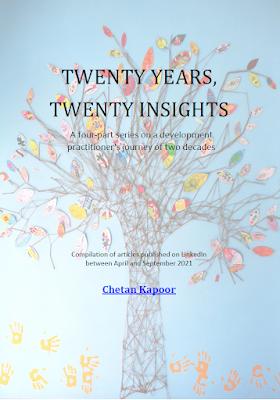The diagnosis is there...can we have the prescription please?
That little boy in Grade 4 of the MCD school gave me a desolate, forlorn look...a look of desperation and helplessness. In front of him, on his desk, was a notebook. On it was his vain attempt to write a simple sentence in Hindi.
Just a few minutes back, as I had walked into this classroom at the school in Nand Nagri in North Shahdara, Delhi, the children had greeted me with their singsong Good Morninnnnng, Sir! I had walked to the back of the class, and had asked this little boy whether he knew how to write. Yes, he had said confidently. Okay, I said, smiling at him. Can you write down this simple sentence? I opened a fresh page on his notebook in front of him, and dictated, "राम आम खाता था", ensuring the words were all of the same easy vowel sound in Hindi (the long aa). He took his pencil, and started to write. Managed to write the first letter र. Added the aa sound to make it रा. Then stopped. Fumbled...thought...gave up. Looked at me with those helpless little eyes. And said something that laid open to me everything that was wrong with our education system. He said, सर, सामने बोर्ड पर लिखा होता है तो देख कर लिख लेते हैं! (Sir, I can write it down if it is written on the board in front of me).
This was 2004. Or maybe 2005. I was still in Pratham, doing my Education 101 as I valiantly tried to manage a mass primary education program that had close to 30,000 children attending remedial or bridge courses each day. One of my favorite activities was to walk into an MCD school (Pratham used to run its remedial education program "Balsakhi" in close to 300 Municipal Corporation of Delhi schools at that time), and observe the classroom activities. The writing test I administered on the child was a part of an initial random assessment that we conducted to develop a remedial program (called "Reading to Learn - R2L", as a follow up to the "Learning to Read - L2R" program) for 3rd and 4th graders. During the visits to these schools, it had become amply clear that we as a nation were staring at a huge human resource deficit, thanks to an inherently faulty education system. This, after all, was Delhi, the capital - the MCD is among the most well resourced municipalities in the country. What would be the state of affairs in the thousands of primary schools that dot our vast rural landscape?
Six years down the line, it appears as if this deficit is finally getting into the popular conscience of our people. In the last two months, three large-scale surveys - the Program for International Student Assessment (PISA), Annual Status of Education Report (ASER), and the NCERT educational survey - have all established the learning deficit that the country faces today. A quick google search reveals that the media has gone to town talking about these reports. So the middle class in India finally knows that if their children are under-performing at their chosen English Medium schools, they are still better off than the millions of other children of the country.
All these surveys are merely diagnostic in nature. They tell us what the problem is. However, none of them really suggests what the prescription is - how do we address this quality deficit. And for a reason - this is one prescription that is nearly impossible to write. How do you redress an education system that has close to a million and a half schools? Or ten million classrooms. 10,000,000 classrooms...imagine that...which are supposed to deliver to nearly 400 million children every day. How do you build the systems and processes to ensure that what goes inside these ten million classrooms adheres to quality norms and parameters... knowing that the classroom process is almost entirely fueled by human effort and capacity?
Can any management expert take a shot at solving this gargantuan problem? Do we see a hand going up...?
 |
| An MCD "school" in Mustafabad in north-east Delhi. A 2004 picture. |
Six years down the line, it appears as if this deficit is finally getting into the popular conscience of our people. In the last two months, three large-scale surveys - the Program for International Student Assessment (PISA), Annual Status of Education Report (ASER), and the NCERT educational survey - have all established the learning deficit that the country faces today. A quick google search reveals that the media has gone to town talking about these reports. So the middle class in India finally knows that if their children are under-performing at their chosen English Medium schools, they are still better off than the millions of other children of the country.
All these surveys are merely diagnostic in nature. They tell us what the problem is. However, none of them really suggests what the prescription is - how do we address this quality deficit. And for a reason - this is one prescription that is nearly impossible to write. How do you redress an education system that has close to a million and a half schools? Or ten million classrooms. 10,000,000 classrooms...imagine that...which are supposed to deliver to nearly 400 million children every day. How do you build the systems and processes to ensure that what goes inside these ten million classrooms adheres to quality norms and parameters... knowing that the classroom process is almost entirely fueled by human effort and capacity?
Can any management expert take a shot at solving this gargantuan problem? Do we see a hand going up...?


Comments
Post a Comment